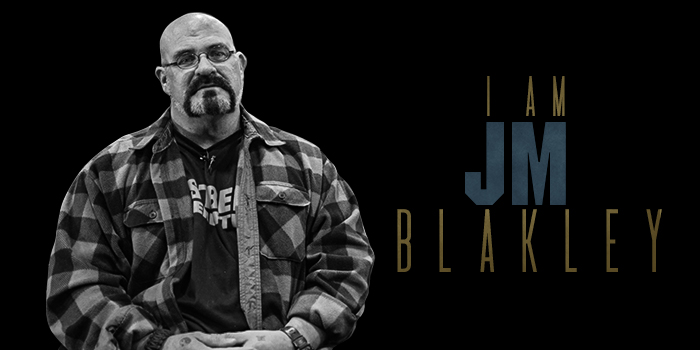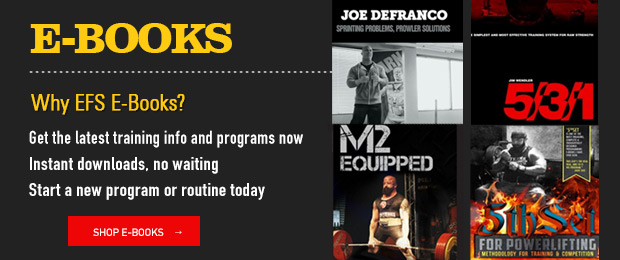
Interview conducted and written by Sydney Schulte & filmed by Josh Goedker
“I’m JM Blakley, and I’m an elitefts columnist and coach.”
JM Blakley, the namesake of the JM Press, grew up north of Youngstown, Ohio, and considers his childhood to be an idyllic, if not blessed, one.
“I had every advantage known to man,” he says. He had professors as grandparents and veterans for uncles and a father, and “all the love any child could wish for.” His parents provided him with that unconditional love and support and encouragement to do anything, none of which had to be shared with any siblings. He did, however, have a pony.
His family was by no means wealthy, at least not financially. But it wasn’t until high school that JM became aware of his family’s finances. But they were rich in their support of JM’s pursuits.
“I wasn’t poor; I had riches. But not those kinds of riches that you can buy stuff with. My riches are other riches, and that’s a great start for any kid.”
One of those riches came in the form of opportunities, and JM found plenty of those when he moved to Columbus, where he worked as an assistant strength coach under Ohio State Buckeyes coach Earl Bruce. JM tried to live in LA for a bit but came scurrying back to Columbus, which would be the place he called home for 30 years (now, he lives back in his hometown, in what used to be his grandfather’s house). He discovered the city had so many opportunities that he couldn’t bring himself to move anywhere else.
“The [Ohio State] University kept giving me free degrees, so I couldn’t say no... I didn’t want to say no. I kept learning for free.”
Those free degrees were in exercise physiology, strength and athletic conditioning, and metaphysical science — all master’s degrees at that, too. Still, one of those things is not quite like the others. Metaphysical science doesn’t quite seem to fit in with the other degrees, which focus on the physical body.
As someone who likes to express himself physically, it made sense for JM to learn as much as he possibly could about the human body. But the physical aspect can only go so far in athletics. It’s missing something: a mental aspect.
Sure, JM could have studied psychology, but he feels there’s something deeper than even psychology can help him understand.
“Something drives the mind, which drives the body, and I call that heart or spirit... These are things you can’t see and are hard to talk about, but you can feel them a lot better.”
Even if these things are hard to talk about, JM does his best to simplify these subjects. It’s similar to his training philosophy: Focus on the basics in order to achieve greatness.
For JM, the basics are the general lifts — bench, squat, and deadlift — chin-ups, and rows with heavy weights to improve strength. Most importantly, the basics include no gimmicks. A gimmick, at least as JM explains it, is an unusual thing that one person finds success with. Then, others will attempt said thing, and it doesn’t work for them.
“You can go all over the board with those things that work for one person, but the basics, in the center of all these gimmicks, never failed anybody. They always work. If you stick with those, you don’t need a gimmick. The basics will take you anywhere you want to go in sports today because most of us are operating at a very low level.”
That’s not meant to be an insult; JM sees it as a fact. Most of us are probably working at “30 percent of our human potential; and the best athletes among us, 40 percent, 45, maybe.”
If anything, people need a little bump to get them to the next range. Say a person’s at 38 percent. If they train JM’s basics, they’ll get that little two-percent bump to 40 percent, where they’re of the best in the world because they are operating above the norm.
“Our human potential is much higher than we recognize.”
The best, according to JM, operate slightly above the average or norm — and those are the people who have great achievements. But they’re not all that great when you look at what we could do.
JM is living proof of the basics leading to greatness, but he still isn’t sure if he’d call that extraordinary or great.
“I was just an ordinary guy who applied the basics all the way at 100 percent. There is nothing spectacular or special about what I did, and I believe that anybody can have a taste of that, just like I did, just by making the sacrifices, showing up, and doing the work, paying the price. So I was willing to pay the price — and that may be where I did something exceptional. Many people are not willing to pay the price.”
Others may avoid paying the price with excuses about their lack of genetic potential when it really comes down to not wanting to work that hard. JM decided to work twice if not three times as hard because he really wanted that reward.
What is the price? It’s not one paid in money. It’s paid in effort, education, and attention.
“Every step you take can’t be repeated. You can’t take 100 steps up and then 100 steps down and expect to get anywhere. You end up right where you started.”
One could argue that training for powerlifting is taking the same 100 steps over and over to keep building up strength. Powerlifters gain weight so they can lift more weight — but JM was infamous for putting on a lot of weight and then losing the weight he gained. Wouldn’t doing that be the same thing over and over again? Why would anyone want to gain weight and strength as a result only to lose that strength?
As it turns out, JM had a method to his madness or at least a strategy. Even though he’d lost that weight, he ensured that he kept some of his strength at a lighter body weight. Doing so put his strength a step higher from where it was the last time he was at that weight. Repeating the weight loss and weight gain in this way actually made JM stronger.
“The trick is simply to ride the normal waves of gaining weight and gaining strength, and then the real trick was to lose the weight without losing all the strength so it wasn’t a zero-sum game.”
And it worked.
Of course, in order for these impressive gains and losses to occur, JM had to watch his calorie intake. This meant he had to eat some crazy meals, especially when it came to bulking. But did any meals stand out from the rest?
While it may not be a meal that would raise some eyebrows, eating a bag of white powdered donuts while training his legs at the gym was a memorable meal for JM. The fact that this became something of a joke also probably helped sear the memory into JM’s mind.
“I didn’t understand why it was so interesting. But everybody was so fascinated, that here’s a guy that is bringing food to the gym and consuming a box of donuts as he’s training... When I found that out, I thought, ‘Well, why not? I want to gain weight, so here I am, training. There’s no rule that says I can’t eat a meal while I’m getting a workout in.’”
Suffice to say, JM stood out in the gym — even at Westside Barbell, one of the most exclusive powerlifting gyms. He didn’t have a whole lot in common with a lot of the lifters there, save for Dave Tate. He and Dave had similar degrees and educational backgrounds, which led to plenty of discussions between the two of them.
“I was sort of the black sheep of Westside Barbell, which is a group of black sheep, and I was sort of not included in that group.”
JM focused on training his bench press while everyone else there trained the Big Three. He was the only male athlete at Westside who would train and travel overseas on a regular basis. He was essentially the face of Westside Barbell overseas, where he would spread the gospel of Louie Simmons, so to speak. Since JM kept winning and was the only one who was willing to travel, Louie gave him permission to travel.
As a result of his travels, JM didn’t train at Westside on a regular basis. Plus, some of the other Westside lifters viewed JM as their competition, so why would they bother speaking with him?
But that didn’t stop JM (and Dave, for that matter) from being cordial with his fellow Westside lifters... even though he was challenged to several fights.
“If you want to fight me, I’m going to decline, but I’ll offer to play you chess.”
Despite the friction between JM and some of the lifters at Westside, he never ended up duking it out in a parking lot for a few reasons: He wasn’t at Westside because he felt he had to prove his masculinity. He wanted to challenge himself.
Maybe they were just mad that JM was smoking them all in the bench — but that wasn’t by choice; at least not on JM’s behalf. Due to a back surgery, he could only bench.
“It is very fortunate for all the lifters I would have beaten.”
Before his surgery, he had aspirations to train all three lifts and to compete in strongman. Sadly, he never had the chance to do so. Despite that, JM looked at the situation with a different perspective.
“The bench was the gateway,” he explains. When his back was hurt, he lost the ability to play the sports he loved and most of the lifts in the gym — except the bench press. He didn’t focus on what he couldn’t do or cry at the unfairness of everything he lost. He dedicated himself to the bench press.
“(The bench press was) all I had. And so I found out through that that when any person takes all of their energies — any human being — marshals all of their energies and puts it in one little spot, they can do a lot with that little spot. So, it’s not a big spot. Bench pressing is not a big part of the world as a whole. But it’s a part of the world I had left, I had access to, and I learned the value of focusing your energies on one thing instead of spreading them out, and I was able to accomplish a little bit.”
JM has accomplished a lot in the worlds of strength and conditioning and powerlifting. He has a bench movement named after him; he’s traveled the world for Westside Barbell; he’s famous for breaking records and winning meets while dropping and gaining weight at breakneck paces. But JM didn’t necessarily choose all of these accomplishments.
If there’s one accomplishment, one legacy, he wishes to leave on the world of strength sports, it’s to fill the dearth of information for the mental and spiritual training.
“If I have any impact that really lasts, it won’t be what I lifted. It won’t be the sets and reps. I hope that it is the insistence that coaches and athletes and self-coached athletes begin to more inner work. I train everyone from the inside out because I learned that myself. That’s where the strength is.”










1 Comment